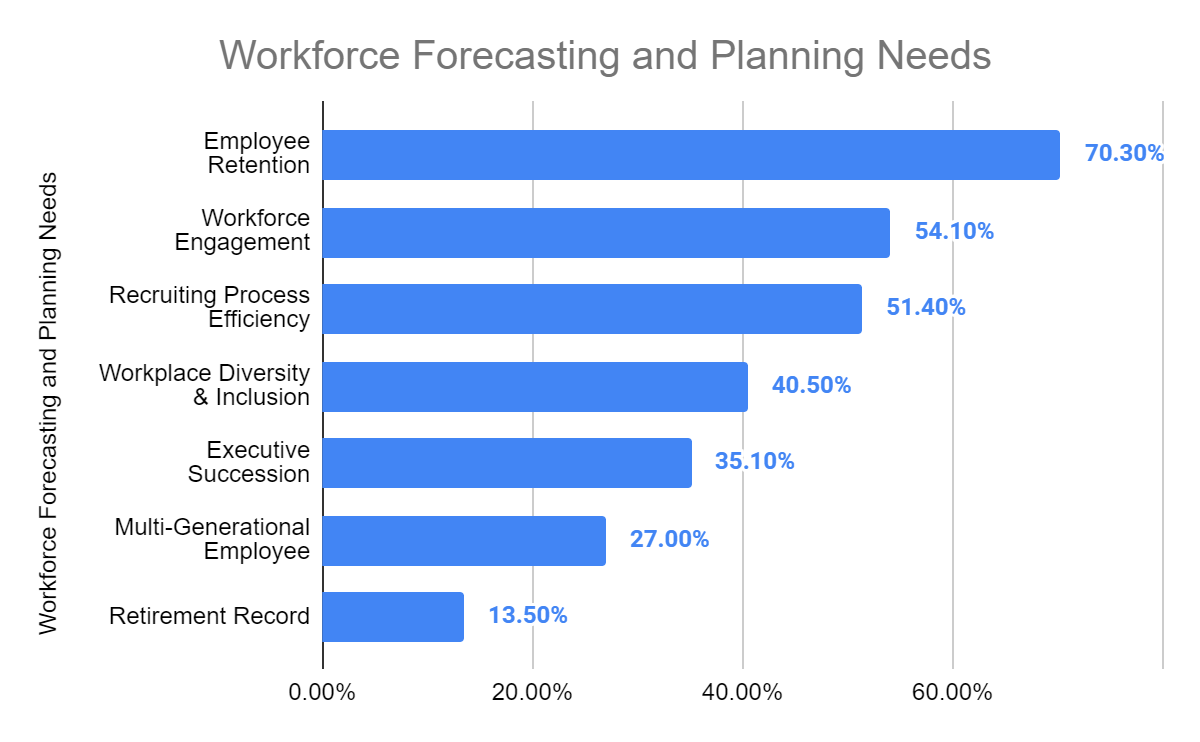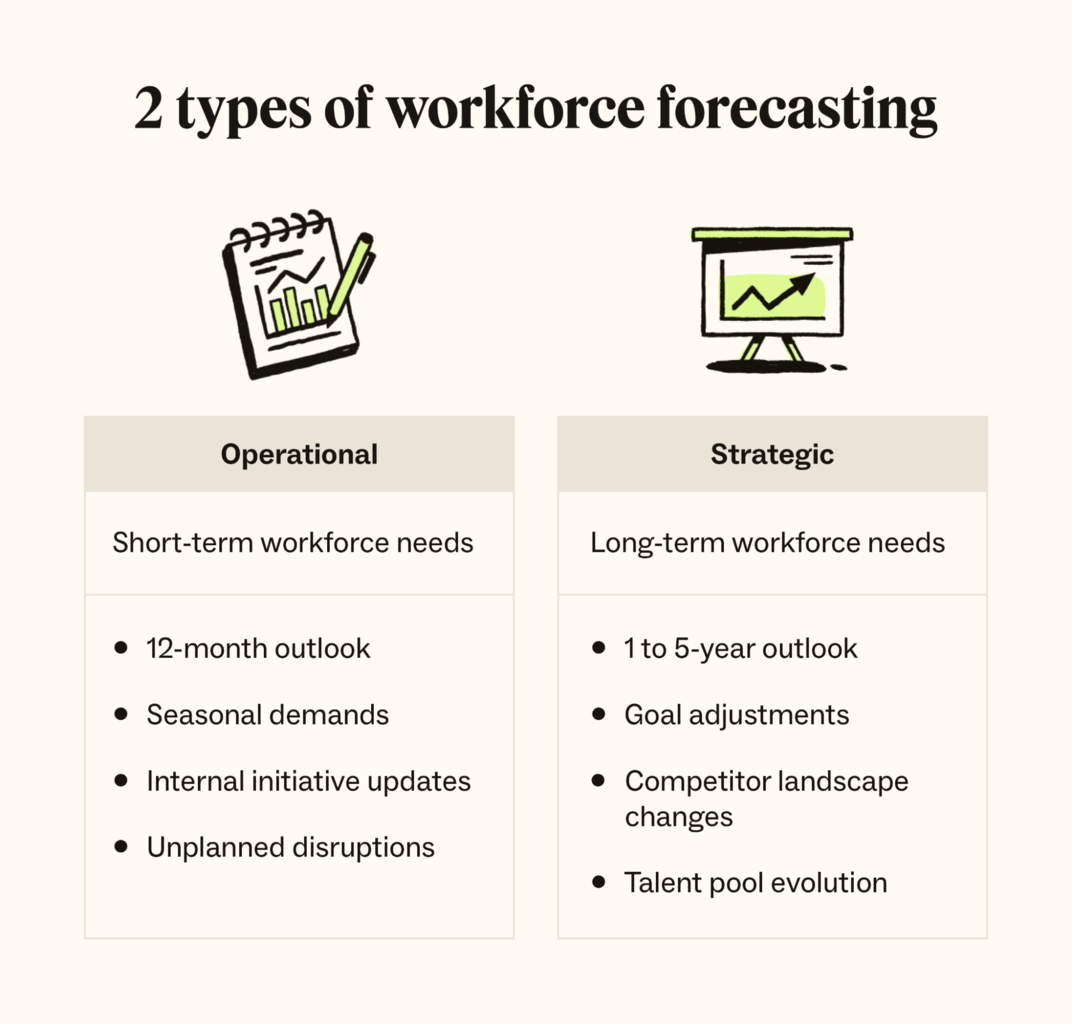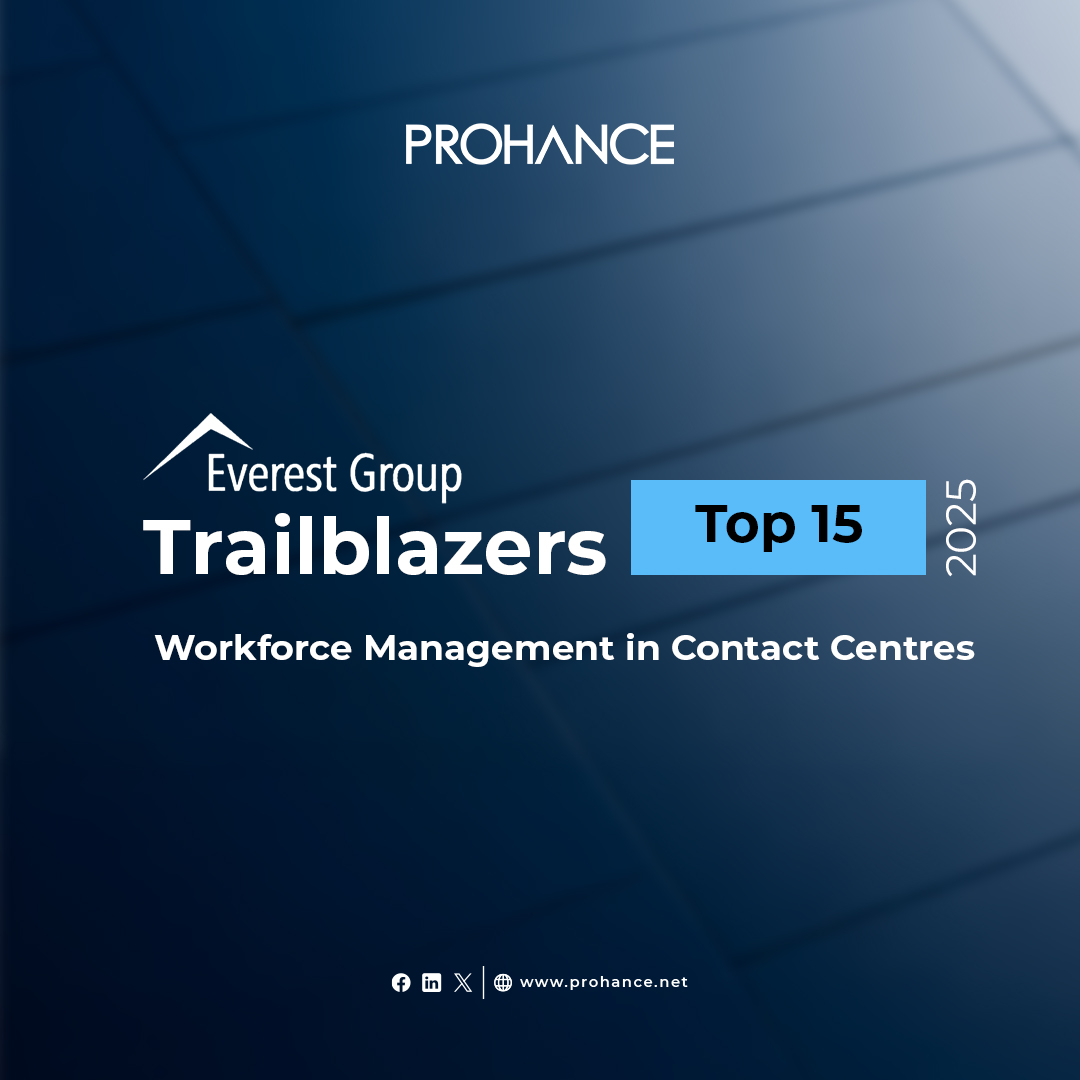How to use workforce forecasting to optimize staffing levels?
Table of contents
Does your organization face difficulty in maintaining staffing levels, coping with unexpected skill gaps or contending with high rates of staff turnover? These are typical problems that can severely affect an organization’s ability to attain its strategic goals. Workforce forecasting offers a solution that enables organizations to predict future staffing needs, match their workforce with business objectives, and stay competitive in a rapidly changing environment.
This all-inclusive manual will examine what workforce forecasting is all about, the models used in it, why we need it, key components of it as well as techniques and tools involved.
What is Workforce Forecasting?
Workforce forecasting involves estimating how many employees an enterprise will require in future depending on certain internal and external factors. It entails analyzing data related to the existing workforce, detecting patterns and then using this knowledge to estimate future demand. The aim here is to ensure that an organization has an adequate number of workers possessing requisite skills at each point in time.
Through workforce forecasting, corporations can plan for their staff ahead of time thereby reducing labor shortages/ surplus while enhancing performance optimization within the labor force.
Such measures contribute greatly towards ensuring smooth running of operations besides cutting down costs as well as achieving strategic goals.
- Companies that undertake Strategic workforce planning and forecasting experience improvements in business outcomes. These include a more than 10% increase in revenue per employee, profit per employee, and revenue growth.
- Apart from business outcomes, strategic workforce forecasting also supports positive talent outcomes: 12% more engagement, retention, and acquisition of top talent.
Workforce Forecasting Models

Workforce forecasting models help to know what the future staffing requirements will be. Depending on the size of the organization, type of industry, and specific needs, workforce forecasting models can be as simple or intricate as required.
Here are a few examples:
Trend Analysis
This is accomplished by going through previous workforce data so as to identify patterns or trends. It is based on an assumption that past trends should continue into future times. With this, organizations can make educated guesses about their upcoming staff needs by considering factors like employee turnover rates, hiring numbers and retirement age among others.
Ratio Analysis
This method forecasts future workforce requirements by comparing two or more variables against each other. An example may involve looking at employees-to-sales revenue ratio or support staff-to-operational staff ratios. In order for them not to change much, having the right number of workers is needed to meet objectives within companies.
Regression Analysis
This model examines dependent-independent relationships using statistical methods called regression analyses. Economic indicators, market conditions and organizational growth might be considered when predicting staffing levels during various periods. It gives better estimates than other methods do since it takes many variables into account at once.
Workforce Simulation
By employing sophisticated computer programs virtual representations of employees are created and different situations acted upon; this is known as workforce simulation. Various strategies for managing workforce planning and forecasting can be tried out by an organization. You can then evaluate their impacts before settling on the most effective approach especially where things are complex and always changing.
The Need for Workforce Forecasting
Workforce prediction is crucial due to many factors which are all important to the success and continuity of an enterprise.

Bridging skill gaps
Organizations can identify possible skill gaps and come up with ways of addressing them in advance by projecting their future workforce requirements. This guarantees that they have adequate personnel capable of accomplishing their strategic goals while staying competitive within the market.
Boosting workforce planning
By giving reliable data on upcoming staffing needs, effective workforce forecasting greatly enhances this area. In turn, information gained through reliable workforce forecasting models enables human resource departments to devise recruitment strategies as well as training and development programs that are in line with corporate objectives.
Cutting down cost
The knowledge of estimating staff levels helps organizations save money by cutting down on overstaffing or understaffing expenses. Companies can reduce labor costs, lower turnover rates among employees and increase overall efficiency if they maintain a proper number of workers.
Supporting business growth
When establishments expand, their workforce demands change too. Therefore, workforce forecasting is necessary for an organization’s ability to scale up its staff numbers in accordance with the level of growth experienced by the business entity. This ensures operational stability can be achieved without disruptions.
Fostering employee engagement
Another reason why accurate predictions about workforces matter lies in their potential for enhancing worker participation through ensuring that no one becomes overburdened or underutilized at work. Consequently, this leads to increased job satisfaction levels among staff members thereby boosting morale which eventually translates into higher productivity levels.
Importance of Workforce Forecasting for Staffing Optimization
1. Efficient Resource Allocation
Workforce planning and forecasting ensure that resources are distributed appropriately. By using workforce forecasting techniques, companies can allocate staff based on demand, reducing bottlenecks and ensuring smooth operations.
2. Cost Control
Accurate workforce management forecasting helps prevent over-staffing or under-staffing, reducing unnecessary labor costs. Workforce forecasting tools provide data-driven insights to maintain financial efficiency.
3. Enhanced Productivity
Workforce forecasting methods ensure the right number of employees are scheduled for tasks, minimizing downtime and maximizing productivity. Effective planning leads to better task distribution and reduced burnout.
4. Improved Employee Satisfaction
Using workforce forecasting software, managers can create balanced schedules. Proper workforce planning and forecasting prevent employee fatigue and improve job satisfaction by ensuring fair workloads.
5. Strategic Decision-Making
Workforce forecasting techniques provide valuable insights for long-term staffing strategies. By analyzing data, businesses can anticipate staffing needs and make informed decisions for growth and expansion.
Workforce Forecasting Techniques and Tools

Workforce forecasting uses different methods and techniques to analyze data and project future staffing requirements. Some of the commonly used methods and techniques are:
Time Series Analysis
Time series analysis involves studying sets of past data points collected over time to discover patterns and trends. It helps in predicting future workforce demand based on previous information. This can be done using spreadsheets or statistical software.
Delphi Method
The Delphi workforce management forecasting method is a consensus-based approach where a group of experts give their independent forecasts, which are then shared among them for further refinement until an agreement is reached. This workforce planning and forecasting method is particularly useful for qualitative forecasting.
Markov Chains
These are mathematical workforce forecasting models that describe transition probabilities from one state to another. For example, they can be used to predict promotions, transfers, and exits within an organization when doing workforce planning or forecasting staff movements in different areas of work.
Scenario Planning
Scenario planning in workforce management forecasting involves creating different possible scenarios about how things might turn out in the future and considering their implications on current decisions. In this case, it would mean developing alternative visions for what might happen regarding staff numbers over time given various assumptions, e.g., budget cuts and new projects.
Human Resource Information Systems (HRIS)
HRIS is an integrated software solution that covers many HR functions, including workforce planning and forecasting. It allows organizations to collect information about all aspects of employees so as to make well informed predictions concerning staffing needs with great accuracy.
Predictive Analytics
The use of statistics together with data mining techniques enable organizations to come up with predictive models which show what is likely to happen next based upon the available data. For example, this method may tell you if employee turnover rate continues increasing then you should expect higher levels of absenteeism also leading to decreased performance thus causing more demand for other workers too.
Also Read: Workforce Analytics in Labor Forecasting
How Workforce Forecasting Helps Optimize Staffing Levels?
1. Predicting Demand Fluctuations
Workforce forecasting tools analyze historical data to predict busy and slow periods. This ensures businesses have the right number of employees during peak and off-peak times.
2. Reducing Overtime Costs
Effective workforce forecasting techniques help minimize excessive overtime by aligning staff availability with workloads. This keeps labor costs under control and prevents employee burnout.
3. Minimizing Under-Staffing Issues
Workforce management forecasting identifies potential gaps in staffing levels. By addressing these gaps early, businesses avoid under-staffing, ensuring smooth operations and customer satisfaction.
4. Dynamic Scheduling
Workforce forecasting methods allow for flexible scheduling based on real-time data. Workforce forecasting software enables managers to adjust schedules dynamically as demands change.
5. Improving Operational Efficiency
By using workforce planning and forecasting, businesses can optimize processes, ensuring tasks are completed efficiently. This leads to streamlined workflows, better resource use, and improved service delivery.
Conclusion
Workforce forecasting is a key component of strategic HRM. It enables firms to align their workforce with business objectives by projecting future staff needs and planning accordingly. Moreover, it helps in promoting efficiency at work which leads to achievement of the desired results within a shorter period.
Regardless of whether you run a small or large scale enterprise, investing in workforce forecasting and workforce tracking tools like ProHance will enable you to identify current skills gaps so that they can be bridged on time. This saves costs while supporting sustainable growth for your organization.
Frequently Asked Question
Q1. What is the impact of inaccurate workforce forecasting?
Inaccurate workforce forecasting can lead to over-staffing or under-staffing, resulting in higher labor costs or poor customer service. Ineffective workforce forecasting techniques may cause employee burnout, low productivity, and operational inefficiencies. Using reliable workforce forecasting tools and workforce forecasting software helps avoid these pitfalls, ensuring accurate workforce planning and forecasting for smooth operations and optimal resource use.
Q2. How can machine learning improve workforce forecasting?
Machine learning enhances workforce management forecasting by analyzing large data sets to detect patterns and trends. Advanced workforce forecasting techniques powered by machine learning improve accuracy by predicting demand fluctuations and staffing needs. Workforce forecasting software that integrates machine learning offers data-driven insights, helping businesses optimize staffing levels through smarter workforce planning and forecasting.
Q3. What tools can be used for workforce forecasting?
Workforce forecasting tools include software like predictive analytics platforms, scheduling systems, and AI-based applications. These tools apply workforce forecasting techniques to analyze historical data and forecast staffing needs. Workforce forecasting software improves workforce management forecasting by automating calculations and providing accurate predictions. Effective use of these tools ensures efficient workforce planning and forecasting for businesses.
Q4. What is the role of predictive analytics in workforce forecasting?
Predictive analytics plays a key role in workforce management forecasting by using historical data to anticipate future staffing needs. Through advanced workforce forecasting techniques, predictive analytics identifies trends and patterns. Workforce forecasting software leveraging predictive analytics helps businesses make informed decisions, ensuring precise workforce planning and forecasting while improving resource allocation and efficiency.
Q5. How technology is shaping workforce forecasting and staffing optimization?
Technology is transforming workforce management forecasting through automation, AI, and data analytics. Modern workforce forecasting software offers real-time insights and precise forecasts, improving staffing efficiency. Workforce forecasting tools use advanced techniques to predict demand, enabling dynamic scheduling. As workforce forecasting methods evolve, businesses can achieve more accurate workforce planning and forecasting, resulting in streamlined operations and cost savings.
Q6. What are the common challenges in workforce forecasting?
Challenges in workforce forecasting include data inaccuracies, sudden market changes, and inefficient workforce forecasting techniques. Poor implementation of workforce forecasting tools or outdated workforce forecasting software can lead to errors in workforce planning and forecasting. Businesses may also struggle with resistance to change or a lack of skilled personnel, impacting workforce management forecasting accuracy.






